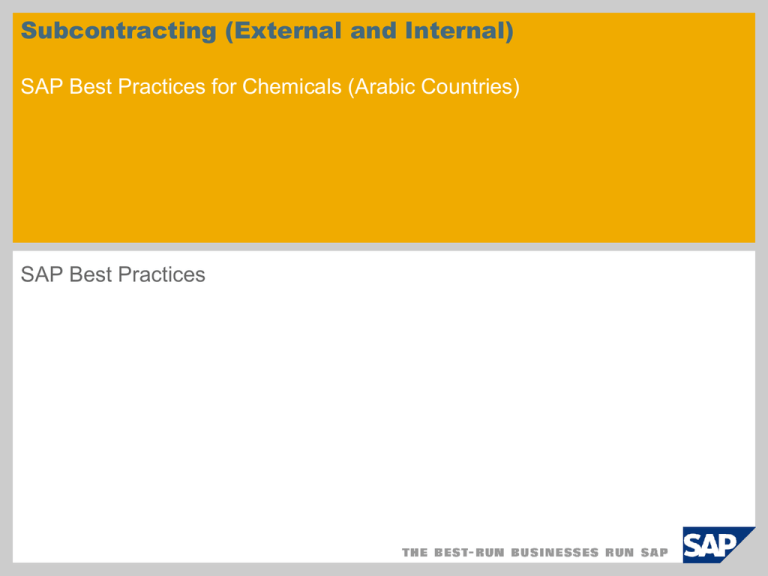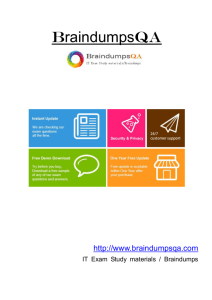
Subcontracting (External and Internal)
SAP Best Practices for Chemicals (Arabic Countries)
SAP Best Practices
Scenario Overview
Purpose and Benefits:
Purpose
The purpose is to describe business processes related to internal and external
subcontracting.
Scenario Overview
SAP Applications Required:
Enhancement Package 4 for SAP ERP 6.0
Company roles involved in process flows:
Warehouse Clerk
Production Worker
Production Planner
Shop Floor Specialist
Quality Specialist
Sales Administration
Purchaser
Accounts Receivable
Scenario Overview
Business Requirement: Outsourcing of manufacturing processes.
External Subcontracting covers manufacturing steps outsourced to a toll-manufacturer,
internal subcontracting covers steps as a toll-manufacturer for a client.
External Subcontracting
Stock Transfer
without
Delivery
Goods Receipt
Quality
Management
Purchase Order
Stock Transfer
with Delivery
Picking
Delivery
Accounts
Payable
Goods Receipt
with
Warehouse
Management
Internal Subcontracting
Order
Processing
MRP
Inventory
Management
Process Order
Processing
Shipping
Invoicing
Business View - 1
Business Benefits
No process time for
Purchaser
Buyer
Sub-Contractor
Plan requirements
Supply material to the
Subcontractor
Generate material
request automatically
Increased
transparency
Assign source of
supply
Create purchase
order and update
contract
Reduced purchasing
process cycle time
Third Party Vendor
Create and validate
sales order (Job
Order)
Provide material
(components) to the
subcontractor
Process material
Business Benefits
Increased customer
satisfaction
Business View - 2
Business Benefits
Buyer
Sub-Contractor
Send out shipping
notification
Increased customer
satisfaction
Confirm goods
receipt
Adjust under and
over consumption
Reduced transaction
cost
Create invoice
Verify and release
invoice
Check and release
payment
Third Party Vendor
Business Benefits
External subcontracting
CH-6210 (GranuSAP, 100 kg)
Purchse order
Delivery of
components
SAPChem AG
Plant 1000
Vendor: S-9000
(subcontractor)
Goods delivery
Invoice
Purchase order for
components with
delivery address to
subcontractor
Delivery to
subcontractor
Invoice
Vendor: S-1003
Process Flow Diagram
Requirement of
Material
(Component)
Requirement of
Subcontracting
Material
Purchaser
Warehouse
Clerk
Quality
Specialist
Accounts
Payable
Account
Receive
Material at
Dock
Subcontract PO
Incoming
Vendor
Invoice
Delivery Note
Third
Party
Vendor Event
Subcontracting (External and Internal)
PO
Create
Subcontract PO
Approve PO
Create PO for
Special Stock
Create Delivery
Request
Post Goods
Issue
Delivery Pick
List
Pick
Confirmation
Print GR Slip
Goods Receipt
Stock transfer for
subcontractor
Inventory GR/IR
Subcontracting
Services/Consumption
Quality
Inspection
GR/IR PPV
Vendor
MRP = Material Requirements Planning, PO = Purchase Order, GR/IR = Goods Receipt/Invoice Receipt, PPV = Purchase Price Variance
Record Results
Invoice Receipt
Internal subcontracting
CH-6800 (PowerPaint, red)
YQFP
PowerPaint, red
CH-6800
Filling
Material
provided
YQNM
Paint, red
CH-0500
VERP
Canister, 5 kg
CH-4200
Plant 1000
WM managed
Mat. type
Description
Mat Nr
QM active
batch managed
Beginning of
Planning
Cycle
Customer
Needs to Buy
Product
Order
Confirmation
MRP List
Creating Planned
Independent
Requirements
MRP
Planned
Orders
Sales
Administration
Convert
Planned Order
to Process
Order
Availability
Check of Non
Provided
Materials
Process Order
Confirmation
Sales Order
Entry
Create Delivery
Request
Inventory
Consumption
@ Standard.
Cost
Sales
Billing
Warehou
se Clerk
Billing
Document
Delivery Note
Shop Floor
Specialist
Production
Planner
Customer
Event
Process Flow Diagram –
Internal Subcontracting
Pick List
Post Goods
Issue
Inventory
COGS
Billing
AR= Accounts Receivable, COGS = Cost of Goods Sold, MRP = Material Requirement Planning
Legend
<Function>
Symbol
Description
Usage
Comments
Band: Identifies a user role, such as Accounts
Payable Clerk or Sales Representative. This band
can also identify an organization unit or group,
rather than a specific role.
Role band
contains tasks
common to that
role.
Symbol
Diagram
Connection
The other process flow symbols in this table go into
these rows. You have as many rows as required to
cover all of the roles in the scenario.
Hardcopy /
Document
External
to SAP
External Events: Contains events that start or end the
scenario, or influence the course of events in the
scenario.
Business
Activity /
Event
Flow line (solid): Line indicates the normal sequence
of steps and direction of flow in the scenario.
Flow line (dashed): Line indicates flow to infrequentlyused or conditional tasks in a scenario. Line can
also lead to documents involved in the process flow.
Connects two
tasks in a
scenario
process or a
non-step event
Business Activity / Event: Identifies an action that
either leads into or out of the scenario, or an outside
Process that happens during the scenario
Does not
correspond to a
task step in the
document
Unit Process: Identifies a task that is covered in a
step-by-step manner in the scenario
Corresponds to
a task step in
the document
SubProcess
Reference
Proces
s
Decisio
n
Usage Comments
To next / From last Diagram: Leads
to the next / previous page of the
Diagram
Flow chart continues on the next /
previous page
Hardcopy / Document: Identifies a
printed document, report, or form
Does not correspond to a task
step in a document; instead, it is
used to reflect a document
generated by a task step; this
shape does not have any outgoing
flow lines
Financial Actuals: Indicates a
financial posting document
Does not correspond to a task
step in a document; instead, it is
used to reflect a document
generated by a task step; this
shape does not have any outgoing
flow lines
Budget Planning: Indicates a
budget planning document
Does not correspond to a task
step in a document; instead, it is
used to reflect a document
generated by a task step; this
shape does not have any outgoing
flow lines
Manual Process: Covers a task
that is manually done
Does not generally correspond to
a task step in a document;
instead, it is used to reflect a task
that is manually performed, such
as unloading a truck in the
warehouse, which affects the
process flow.
Existing Version / Data: This block
covers data that feeds in from an
external process
Does not generally correspond to
a task step in a document;
instead, this shape reflects data
coming from an external source;
this step does not have any
incoming flow lines
System Pass / Fail Decision: This
block covers an automatic
decision made by the software
Does not generally correspond to
a task step in the document;
instead it is used to reflect an
automatic decision by the system
that is made after a step has been
executed.
Financial
Actuals
Budget
Planning
Manual
Proces
s
Unit Process
Process
Reference
Description
Process Reference: If the scenario references another
scenario in total, put the scenario number and name
here.
Sub-Process Reference: If the scenario references
another scenario in part, put the scenario number,
name, and the step numbers from that scenario here
Process Decision: Identifies a decision / branching
point, signifying a choice to be made by the end
user. Lines represent different choices emerging
from different parts of the diamond.
Corresponds to
a task step in
the document
Corresponds to
a task step in
the document
Does not
usually
correspond to a
task step in the
document;
Reflects a
choice to be
made after step
execution
Existing
Version /
Data
System
Pass/F
ail
Decisio
n
© 2011 SAP AG. All rights reserved.
No part of this publication may be reproduced or transmitted in any form or for any purpose without the express permission of SAP AG. The information contained herein may be changed
without prior notice.
Some software products marketed by SAP AG and its distributors contain proprietary software components of other software vendors.
Microsoft, Windows, Excel, Outlook, and PowerPoint are registered trademarks of Microsoft Corporation.
IBM, DB2, DB2 Universal Database, System i, System i5, System p, System p5, System x, System z, System z10, System z9, z10, z9, iSeries, pSeries, xSeries, zSeries, eServer, z/VM, z/OS,
i5/OS, S/390, OS/390, OS/400, AS/400, S/390 Parallel Enterprise Server, PowerVM, Power Architecture, POWER6+, POWER6, POWER5+, POWER5, POWER, OpenPower, PowerPC,
BatchPipes, BladeCenter, System Storage, GPFS, HACMP, RETAIN, DB2 Connect, RACF, Redbooks, OS/2, Parallel Sysplex, MVS/ESA, AIX, Intelligent Miner, WebSphere, Netfinity, Tivoli and
Informix are trademarks or registered trademarks of IBM Corporation.
Linux is the registered trademark of Linus Torvalds in the U.S. and other countries.
Adobe, the Adobe logo, Acrobat, PostScript, and Reader are either trademarks or registered trademarks of Adobe Systems Incorporated in the United States and/or other countries.
Oracle is a registered trademark of Oracle Corporation.
UNIX, X/Open, OSF/1, and Motif are registered trademarks of the Open Group.
Citrix, ICA, Program Neighborhood, MetaFrame, WinFrame, VideoFrame, and MultiWin are trademarks or registered trademarks of Citrix Systems, Inc.
HTML, XML, XHTML and W3C are trademarks or registered trademarks of W3C®, World Wide Web Consortium, Massachusetts Institute of Technology.
Java is a registered trademark of Sun Microsystems, Inc.
JavaScript is a registered trademark of Sun Microsystems, Inc., used under license for technology invented and implemented by Netscape.
SAP, R/3, SAP NetWeaver, Duet, PartnerEdge, ByDesign, Clear Enterprise, SAP BusinessObjects Explorer, and other SAP products and services mentioned herein as well as their respective
logos are trademarks or registered trademarks of SAP AG in Germany and other countries.
Business Objects and the Business Objects logo, BusinessObjects, Crystal Reports, Crystal Decisions, Web Intelligence, Xcelsius, and other Business Objects products and services mentioned
herein as well as their respective logos are trademarks or registered trademarks of SAP France in the United States and in other countries.
All other product and service names mentioned are the trademarks of their respective companies. Data contained in this document serves informational purposes only. National product
specifications may vary.
The information in this document is proprietary to SAP. No part of this document may be reproduced, copied, or transmitted in any form or for any purpose without the express prior written
permission of SAP AG.
This document is a preliminary version and not subject to your license agreement or any other agreement with SAP. This document contains only intended strategies, developments, and
functionalities of the SAP® product and is not intended to be binding upon SAP to any particular course of business, product strategy, and/or development. Please note that this document is
subject to change and may be changed by SAP at any time without notice.
SAP assumes no responsibility for errors or omissions in this document. SAP does not warrant the accuracy or completeness of the information, text, graphics, links, or other items contained
within this material. This document is provided without a warranty of any kind, either express or implied, including but not limited to the implied warranties of merchantability, fitness for a
particular purpose, or non-infringement.
SAP shall have no liability for damages of any kind including without limitation direct, special, indirect, or consequential damages that may result from the use of these materials. This limitation
shall not apply in cases of intent or gross negligence.
The statutory liability for personal injury and defective products is not affected. SAP has no control over the information that you may access through the use of hot links contained in these
materials and does not endorse your use of third-party Web pages nor provide any warranty whatsoever relating to third-party Web pages.





